A reckoning in Charlottesville
 Joel Gunter
Joel GunterIn the middle of Emancipation Park in Charlottesville on Saturday, two young women, one white and one black, took each other's hands and held them tightly, and with their other hands they gripped the steel barrier in front of them.
A few feet away, a young white man with a buzzed haircut and sunglasses leaned towards them over a facing barrier. "You'll be on the first f*****g boat home," he screamed at the black woman, before turning to the white woman. "And as for you," he said coolly, "you're going straight to hell." Then he gave a Nazi salute.
For the third time in a few months, white nationalists had descended on the small, liberal city of Charlottesville in the southern state of Virginia, to protest against the planned removal of a statue of Confederate general Robert E Lee.
This time they came under the banner of the so-called "alt-right", for a rally they called "Unite the Right". They were a motley crew of militia, racists, and neo-Nazis, and some who said they simply wanted to defend their Southern history.
They gathered early in the morning at Emancipation Park - formerly Lee Park - where the statue sits. Some were dressed in full tactical gear and openly carrying rifles. Others wore black shirts, helmets, and boots.
In a column they surged into the park, using sticks and their fists to shove aside anti-fascist counter-protesters. Then they blocked off the entrance with shields. Inside, David Duke, the former grand wizard of the Ku Klux Klan, grinned and waved as the crowd, almost entirely white and male, cheered him on, chanting his name and putting their arms up in Nazi salutes.
They had reason to be pleased. They were in the middle of the largest gathering of white nationalists in America for decades.
 Reuters
Reuters Reuters
ReutersIn the park, in a pen ringed by steel barriers, the nationalists shouted anti-immigrant, anti-semitic and racist slogans and targeted white women counter-protesters, calling them "traitors" who "needed to get subjugated". Outside, anti-fascist protesters threw bottles, rocks and paint and chanted "Off our streets, Nazi scum". Pepper spray, used by both sides, filled the air.
Eventually, riot police moved into the park and the streets around it, pushing everyone back. The governor of Virginia declared a state of emergency and the rally was cancelled. The national guard began to close off the area, but not before a driver ploughed into a crowd of counter-protesters two blocks away, killing a young woman and injuring 19 others.
'One long prayer'
Twenty-four hours earlier, Reverend Brenda Brown-Grooms closed her eyes and prayed for peace. Sitting in a side room at St Paul's Memorial Church, while volunteers undertook non-violent resistance training next door, she prepared herself for a "reckoning" the following day in her home town.
"This is physically a very beautiful place, it has always been my template for what a city should look like," she said. "But I've always understood that this beautiful place is also quite ugly. And the statue has become the match point for that ugliness."
Reverend Brown-Grooms was born in Charlottesville in 1955. She grew up in Vinegar Hill, a black neighbourhood since razed to the ground in one of a series of redevelopment programmes that pushed the black community out of the city and into housing projects.
As a girl, under segregation, she did not dare set foot in the white neighbourhood which was home to Emancipation Park - then Lee Park - and she had never been there until May, when the KKK came to town and lit torches under the statue.
"This summer has been one long prayer here in Charlottesville," she said. "And now today we are praying again, we are praying that the alt-right don't start something tonight, ahead of the rally."
 Joel Gunter
Joel GunterWithin a few hours, her prayer went unanswered. About 200 white nationalists gathered after dark in Nameless Field, down the road from where she sat, and marched through the University of Virginia campus holding torches. They chanted "Blood and soil" - an old Nazi slogan - and "Jews will not replace us".
At the base of the university's statue of Thomas Jefferson, on the Main Street side of the campus, they were met by university students who came to resist them, linking arms and surrounding the statue. The air was hot from the torches and acrid from smoke.
"The heat here is nothing compared to what you're going to get in the ovens," shouted Robert Ray, a writer for the white supremacist website Daily Stormer. "It's coming," he spat.
"White supremacists walking through my university with torches, I never thought I'd have to see this in America in my lifetime," said one of the counter-protesters, a student who did not want to be named.
 Joel Gunter
Joel GunterDirectly across the street, at the same time, more than 500 people were packed into St. Paul's church for a multi-faith service. There were readings from the Bible and the Koran, spirituals sung by a choir, and a speech by activist and Harvard professor Dr Cornel West that drew everyone in the house to their feet.
"It is bleak that we are about to see the largest neo-fascist gathering in decades, but it is also a joy to be able to struggle against it, to bear witness to it," said Dr West after the service.
"The alt-right is a new danger. We have a right-wing gangster in the White House who emboldens them, who empowers them. So they feel they have permission for their hate to come out in public, and maybe even harm others. We are in a dangerous moment."
As the service drew to a close, and the last spirituals were sung, the congregation filed slowly out of a side door to avoid the white nationalists who were walking back up Main Street.
'Racial realism'
The speakers booked for the rally in Charlottesville were all men. The people who came to attend the rally were almost all men, and across the country the following of the so-called "alt-right" is overwhelmingly male.
One of the few women who speaks regularly at white nationalist events is Avialae Horton, a 20-year-old from Georgia who is editor of the Revolutionary Conservative, an online, right-wing newspaper with a mission to "defend Western civilisation".
The members of the "new-right" are being unfairly branded as "Nazis and fascists", she said in Charlottesville ahead of the rally. "We stand in confidence in our convictions, irrespective of what others think of that. And I absolutely believe that we have been misrepresented."
 Reuters
ReutersThree women from the Revolutionary Conservative flew into Charlottesville for the rally. They preach what they call "racial realism", which they say is not racism.
"It's natural for people to want to be with their own kind, and to look to their own interests," said RS McCoy, another member of staff from the paper, who came from California.
"We're going to care about our interests first, black people are going to care about their interests first, and even moving outside of race into things like LGBT, they're going to care about their interests first. And that is not bad, it doesn't have to be demonised."


The removal of the Robert E Lee statue in Charlottesville, and the removal of other Confederate statues in the South, threatened to strip away American history, Ms McCoy said.
According to the Southern Poverty Law Center, more than 60 Confederate monuments or symbols have been removed or renamed since the 2015 massacre of nine black churchgoers in Charleston, South Carolina, by white supremacist Dylann Roof.
Tearing down the statues was depriving black Americans of the chance to learn their own history, said Ms McCoy.
"If we look at it from their perspective even, which is you know - Oh we've had slavery and racism and all these horrible things and we want to make this go away, so we're going to tear down monuments and rename all these streets - how are future generations going to learn?"
Standing in the middle of Emancipation Park on Friday, looking up at the statue of Robert E Lee, the city's deputy mayor Wes Bellamy took a different view.
 Joel Gunter
Joel GunterMr Bellamy is the first black deputy mayor of the city. A sharply-dressed, outgoing character, emphatic in his desire to see the statue removed - "155%" - he has become a lightning rod for people who believe their heritage is being torn up.
"I get hate mail and death threats every day. I've been told I will be hung from this statue. I've been told I will be hung from the trees in this park," he said.
"But that lets you know what you're doing is right. How can you have a 28ft statue to a man who, if he were alive today, I would not be allowed to look in the eye? Who, if he were walking down the street, would make me walk off the sidewalk? How can we have that statue here, if we are to be an equitable city?"
Mr Bellamy stopped in the park to speak to residents, who congratulated him on passing his doctorate that day, and to local police officers, some of whom he knew by name. Then he headed off, under strict instructions from police, as the white nationalists came into town, to keep his whereabouts on Saturday a secret.
Joy Town, USA
As the National Guard closed down the streets around Emancipation Park on Saturday evening, the protesters dissipated into smaller skirmishes nearby. Daryl Vaughan, 24, who came from Newcastle, Virginia to join the white nationalists, got caught alone, surrounded by anti-fascist protesters who beat him, kicking him in the face and chest as he lay on the ground.
Bloodied, he retreated to a side street. "They've come here to take my history away, to make my history look bad," he said. "Black lives matter, that's bullshit to me."
A few hundred white nationalists moved north and gathered in McIntyre Park, but with little attention on them in the large, open park, they began to disperse, some marching in a column along the highway to their cars, while passing drivers honked in support or hurled abuse.
 Joel Gunter
Joel GunterSlowly the chaos and violence of earlier gave way to reflection and to tragedy. A 32-year-old woman had been killed, run over by a man who ploughed into peaceful counter-protesters on the street near Emancipation Park, and who was later arrested and charged with murder.
In a separate incident, two state police employees died when their helicopter, which had hovered over downtown Charlottesville for most of the day observing the rally, crashed.
"Condolences to the family of the young woman killed today, and best regards to all of those injured, in Charlottesville, Virginia. So sad!," the president tweeted.
It was left to Terry McAuliffe, the governor of Virginia, to condemn the white nationalists that poured into the city from around the country. "Go home," he said at a press conference. "There is no place for you here."
Three years ago, the US National Bureau of Economic Research named Charlottesville America's happiest city. "Joy Town, USA", the media called it.
But spirits were low around Joy Town on Saturday. "I wonder if Charlottesville will ever be the same after this," said Henry McHenry, 63, as he watched the National Guard march past his home of 30 years. "We must get past this state of us against them," he said.
Late on Saturday night, after a long day that began with a dawn prayer service at 6am, Reverend Brown-Grooms tried to make some sense of what she had seen on the streets of her city that day.
"I come from a people who were enslaved, and to make it through that misery there has to be a spirit which allows you to see past what your eyes see in front of you and what your ears hear, and to understand how hope forms in your heart," she said.
"As our people used to say, trouble don't last always. It might last all of my lifetime, but not always."
